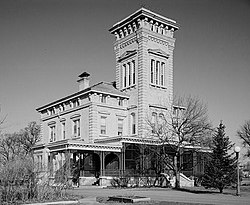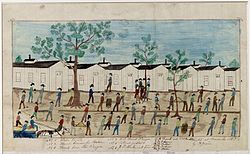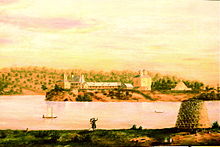Rock Island Arsenal
| Rock Island Arsenal | |
|---|---|
| Rock Island Arsenal, Rock Island Township / Moline Township, Rock Island County, Illinois | |
| Type | Army post |
| Site information | |
| Controlled by | U.S. Army |
| Website | Official Website |
| Site history | |
| Built | 1862 |
| In use | 1862–present |
| Garrison information | |
| Garrison | Joint Munitions Command Joint Manufacturing and Technology Center U.S. Army Corps of Engineers, Rock Island District United States Army Sustainment Command First United States Army |
Rock Island Arsenal | |
 Rock Island Arsenal, Quarters 1 (Building 301) | |
| Location | Rock Island, Illinois |
|---|---|
| Coordinates | 41°31′1″N 90°32′31″W / 41.51694°N 90.54194°W |
| Built | 1832 |
| Architect | General Thomas J. Rodman et al. |
| Architectural style | Greek Revival, Italianate |
| NRHP reference No. | 69000057 |
| Significant dates | |
| Added to NRHP | September 30, 1969[1] |
| Designated NHLD | June 7, 1988[2] |
| Rock Island Military Prison | |
|---|---|
| Part of American Civil War prison camps | |
 Union prison at Rock Island, during the American Civil War, circa 1863–1865 | |
| Type | Union Prison Camp |
| Site information | |
| Owner | U.S. Government |
| Controlled by | Union Army |
| Open to the public | No |
| Site history | |
| In use | December 1863-July 1865 |
| Battles/wars | American Civil War |
| Garrison information | |
| Occupants | Union soldiers, Confederate prisoners of war |


The Rock Island Arsenal comprises 946 acres (383 ha), located on Arsenal Island, originally known as Rock Island, on the Mississippi River between the cities of Davenport, Iowa, and Rock Island, Illinois. It lies within the state of Illinois. Rock Island was previously used as the summer camp site for Sauk Native Americans, and the dispute over tribal ownership led to the Black Hawk War of 1832, after the primary leader of the Sauk, Black Hawk. It is now home of First Army headquarters, and the US Army's Center of Excellence for Additive Manufacturing.[3]
The island was originally established as a government site in 1816, with the building of Fort Armstrong. It is now the largest government-owned weapons manufacturing arsenal in the United States.[4] It has manufactured military equipment and ordnance since the 1880s. In 1919–1920 one hundred of the Anglo-American or Liberty Mark VIII tanks were manufactured, although too late for World War I. It is designated as a National Historic Landmark.
Established as both an arsenal and a center for the manufacture of leather accoutrements and field gear, today it provides manufacturing, logistics, and base support services for the Armed Forces. The Arsenal is the only active U.S. Army foundry, and manufactures ordnance and equipment, including artillery, gun mounts, recoil mechanisms, small arms, aircraft weapons sub-systems, grenade launchers, weapons simulators, and a host of associated components.[5] Some of the Arsenal's most successful products include the M198 and M119 towed howitzers, and the M1A1 gun mount. About 250 military personnel and 6,000 civilians work there. The 2000 census population was 145.
History
From the autobiography of Sauk Native American Black Hawk: "When we arrived we found that the troops had come to build a fort on Rock Island...We did not object, however, to their building their fort on the island, but were very sorry, as this was the best one on the Mississippi, and had long been the resort of our young people during the summer. It was our garden, like the white people have near their big villages, which supplied us with strawberries, blackberries, gooseberries, plums, apples and nuts of different kinds."
The island facilities were converted and built in 1863; they were not yet completed in December of that year, when the first Confederate prisoners were incarcerated. The construction was makeshift. The first prisoners were 468 Confederates captured in battles at Chattanooga, Tennessee. That month more than 5,000 Confederates would swell the population of Rock Island military prison. They were kept in 84 barracks, each holding around 100 prisoners.[6] A total of 41 Confederate prisoners successfully escaped during the prison's operation, and many more would try but fail.[7][8]
A total of 1,964 Confederate prisoners and 125 Union guards are buried in the adjacent military cemetery, including 49 members of the 108th Regiment of United States Colored Troops, who served as guards. Most died from disease, since sanitation was primitive as in all army encampments, and exposure to heat and humidity during the summers and freezing temperatures during winters. In 1864, deadly smallpox epidemics rapidly spread through the prison.
The prison camp operated from December 1863 until July 1865, when the last prisoners were freed. After the war, the prison facility was completely destroyed. During its two years in operation, the prison camp housed a total of more than 12,400 Confederates.[7][8]
Other historical sites in the area include the Confederate Cemetery, the Rock Island National Cemetery, 19th-century stone workshops, officers' quarters along the river, Col. Davenport's House, and the site of the first bridge built across the Mississippi. Following the war, the federal government retained ownership of Arsenal Island and developed it for use as an arsenal and ordnance manufacturing center, which led to its being renamed.
Rock Island Arsenal Museum
The Rock Island Arsenal Museum was established on July 4, 1905. It is the second-oldest US Army Museum in the US after the West Point Museum. The museum has been closed twice, during World War I and World War II, to provide more space for manufacturing facilities.
Exhibits interpret the history of Rock Island Arsenal and the Union prison camp during the American Civil War, and the site's role as a military industrial facility. The museum contains the second-largest collection of small arms weapons in the U.S. Army, and an outdoor vehicle display.
Indoor exhibits include (as of June 2012):
| Weapon name | Country of origin | Period |
|---|---|---|
| M1 75mm Pack Howitzer on M8E1 Mount | 1927–present | |
| M40A1 106mm Recoilless Rifle with 50 caliber spotting rifle | 1950s–present | |
| M45 Quadmount "Quad 50" 50 caliber machine gun turret | World War II – 1980s | |
| M14 conversion display to M14 Enhanced Battle Rifle (RI) | 1959–present |
Outdoor exhibits include (as of June 2012):
See also
- Black Hawk
- American Civil War
- List of Civil War POW Prisons and Camps
- Prisoner-of-war camp
- List of National Historic Landmarks in Illinois
References
- ^ "National Register Information System". National Register of Historic Places. National Park Service. January 23, 2007.
- ^ "Rock Island Arsenal". National Historic Landmark summary listing. National Park Service. Archived from the original on 2006-02-13. Retrieved 2007-10-13.
- ^ ASA(ALT) Assistant Secretary of the Army (Acquisition, Logistics and Technology) (Friday, October 4, 2019) Army Advanced Manufacturing Initiative
- Ryan McCarthy (18 September 2019) Army Directive 2019-29 (Enabling Readiness and Modernization Through Advanced Manufacturing) This directive is to be implemented by Materiel Command and Futures Command; the proponent will be ASA(ALT)
- Mark Esper (07 Dec 2018) Army Directive 2018-26 (Enabling Modernization Through the Management of Intellectual Property)
- Sydney J. Freedberg Jr. (October 23, 2019) Army’s 3D Printing Hub Will Be Rock Island: Gen. Perna The 10 Active Army divisions each have a deployable 3D printer as part of the Metal Working & Machining Shop Set (MWMSS), in expandable mobile containers. The 3D designs are downloaded from an interim digital repository developed in-house by Army Futures Command.
- Industry Week Staff (May 21, 2019) Additive Manufacturing Center of Excellence Opens at Army Center Rock Island Arsenal (RIA)
- Sgt. Travis M. O'Brien (January 4, 2016) Advanced shop sets for Soldiers' advanced skill sets MWMSS for MOS 91Es
- ^ "Rock Island Arsenal". GlobalSecurity.org. Retrieved 2008-10-13.
- ^ "Joint Manufacturing & Technology Center - Rock Island Arsenal". U.S. Army. Archived from the original on 2009-04-10. Retrieved 2009-09-25.
- ^ The Civil War in America, The Library of Congress
- ^ a b Chestnut, Mary (1982). A Diary from Dixie. Gramercy Books, New York. ISBN 0-517-18266-1.
- ^ a b Speer, Lonnie R. (1997). Portals to Hell: Military Prisons of the Civil War. Mechanicsburg, PA: Stackpole Books, c1997. ISBN 0-8032-9342-9.
External links
- Historic American Engineering Record (HAER) No. IL-20, "Rock Island Arsenal"
- Official website
- The Rock Island Arsenal Joint Manufacturing & Technology Center (archive link)
- The Rock Island Arsenal profile at globalsecurity.org
- Rock Island Arsenal Museum
- Rock Island Civil War prison (archive link)
- Rock Island National Cemetery, Arsenal, and Confederate POW Camp
- Rock Island Memorial POW Camp #2229
- Rock Island Arsenal Wikimapia
- 1816 establishments in Illinois Territory
- United States Army posts
- Illinois in the American Civil War
- American Civil War prison camps
- Defunct prisons in Illinois
- Prison islands
- Islands of Illinois
- Tourist attractions in Rock Island, Illinois
- United States Army arsenals
- National Historic Landmarks in Illinois
- Military installations in Illinois
- Economy of the Quad Cities
- Tourist attractions in the Quad Cities
- Quad Cities
- Military and war museums in Illinois
- Museums in Rock Island County, Illinois
- National Register of Historic Places in Rock Island County, Illinois
- Military facilities on the National Register of Historic Places in Illinois
- Archaeological sites on the National Register of Historic Places in Illinois
- Armories on the National Register of Historic Places in Illinois
- Industrial buildings and structures on the National Register of Historic Places in Illinois
- United States Army arsenals during World War II
- Historic American Engineering Record in Illinois
- Landforms of Rock Island County, Illinois
- American Civil War on the National Register of Historic Places
- Historic districts on the National Register of Historic Places in Illinois




